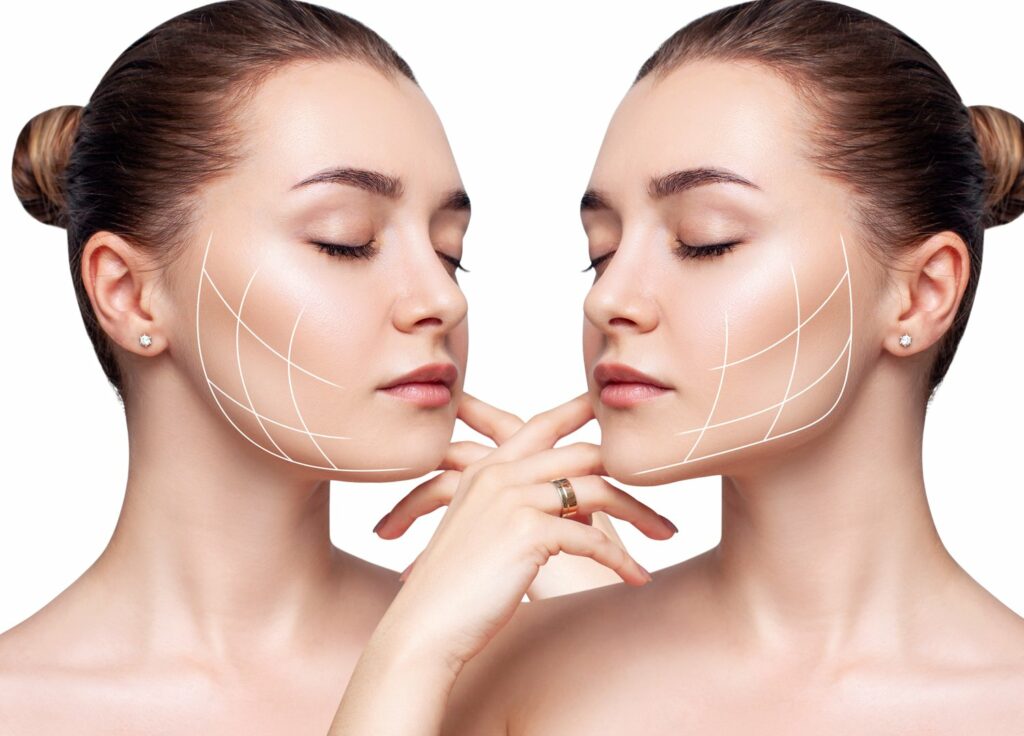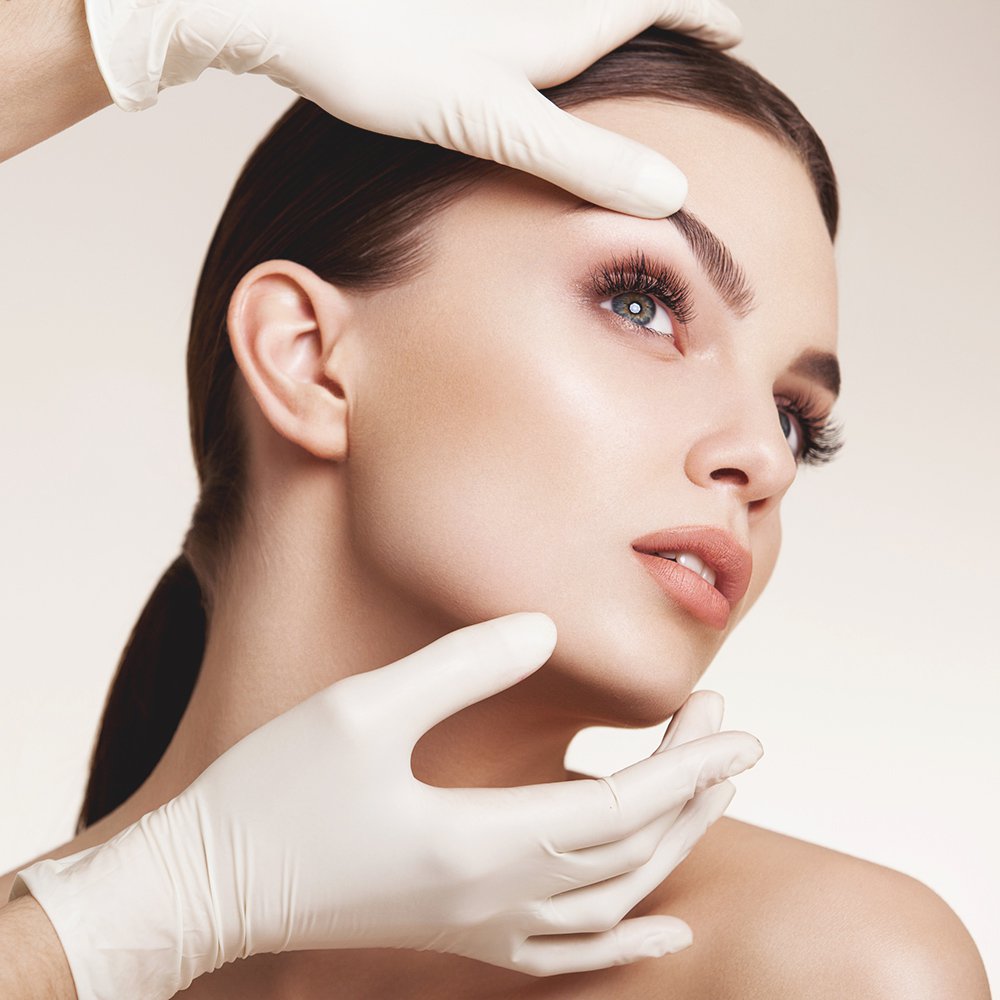Chin Aesthetics
Chin aesthetics refers to the study, appreciation, and enhancement of the visual harmony and balance of the chin with the overall facial structure. In cosmetic and aesthetic medicine, the chin plays a significant role in defining a person’s facial proportions, symmetry, and attractiveness.
The chin should ideally harmonize with other facial features like the nose, cheeks, and forehead. Ideally, the chin should be proportionate to the mid-face and lower-face heights. The chin’s forward projection should be in balance with the nose and forehead. An under-projected chin can make the nose appear more prominent, while an over-projected chin can make the nose appear smaller. Various treatment options exist for individuals seeking to enhance their chin aesthetics. These options range from non-invasive procedures like dermal fillers to surgical interventions like genioplasty or chin implants. The choice of treatments depends on the individual’s desired outcome, budget, and the recommendation of a qualified aesthetic or plastic surgeon. Chin aesthetics is an essential aspect of facial harmony and attractiveness. A well-balanced and proportionate chin can significantly improve an individual’s overall appearance and self-confidence. As Unimed Health team, we bring you together with Turkey’s best plastic surgeons for this purpose.

Types of the Chin Aesthetics
Chin aesthetic surgery procedures aim to enhance the appearance of the chin by altering its size, shape, or projection. There are several types of chin aesthetic surgery procedures, including:
Genioplasty (Chin Surgery): Genioplasty is a surgical procedure that involves repositioning the chin bone (mandible) to correct its size, shape, and projection. There are two main types of genioplasty:
a. Sliding genioplasty:In this procedure, a section of the chin bone is cut and moved forward or backward, depending on the desired change in chin projection. The bone is then secured in place using plates and screws. Sliding genioplasty is effective in addressing both under- and over-projected chins.
b. Vertical genioplasty:This technique is used to arrange the vertical height of the chin. A section of the chin bone is either removed or added to increase or decrease the chin’s vertical height.
Chin implants: Chin augmentation with implants involves the insertion of a biocompatible material (usually silicone or porous polyethylene) to enhance the chin’s size and projection. The implants come in various shapes and sizes and can be customized to get the desired outcome. This procedure is less invasive than genioplasty and has a shorter recovery time.
Fat grafting: Fat grafting, also known as autologous fat transfer, involves harvesting fat from the patient’s body (usually from areas such as the abdomen or thighs) and injecting it into the chin area to improve contour and projection. This method is minimally invasive, and the results can be pretty natural-looking.
Tissue fillers: Although not a surgical procedure, injectable dermal fillers might be a non-invasive alternative to surgery for patients seeking minor adjustments to their chin aesthetics. Fillers like hyaluronic acid can be injected into the chin area to improve its size, shape, or projection temporarily. The results typically last for several months, and the procedure can be repeated as needed.
Each of these chin aesthetic surgery procedures offers unique benefits and drawbacks. The choice of method depends on the patient’s specific concerns, desired outcome, and the professional recommendation of a qualified plastic surgeon. It is crucial to have a thorough consultation with a plastic surgeon to discuss the most suitable options and ensure the best possible results.

Who is Suitable for Chin Aesthetic?
Ideal candidates are generally in good overall health and free from medical conditions that may complicate surgery or impede the healing process. Non-smokers or those willing to quit smoking before and after the procedure will also experience better outcomes. Furthermore, suitable candidates should have realistic expectations about the results and be prepared to follow their surgeon’s post-operative care instructions closely. A complete consultation with a qualified plastic surgeon is essential to determine whether a person is a good candidate for a chin aesthetic procedure, considering the patient’s specific concerns and goals.
The Operation Process of Chin Aesthetics
The performing process of a chin aesthetic begins with a thorough consultation with a qualified plastic surgeon to discuss the patient’s concerns, goals, and medical history. Once the patient is deemed a suitable candidate, the surgeon will suggest the most appropriate technique, such as genioplasty, chin implants, or dermal fillers. On the day of the procedure, the patient will be given general or local anesthesia, depending on the chosen technique. For a genioplasty, the surgeon will make an incision inside the mouth or under the chin, carefully cut and reposition the chin bone, and secure it with plates and screws. In the case of chin implants, an incision is made either under the chin or inside the mouth. A pocket is created for the implant. Then the implant is placed and secured. If dermal fillers are used, the surgeon will inject the chosen filler material into the chin area to improve its size, shape, or projection. Once the surgical procedure is completed, the incisions will be closed with sutures. And then, the patient will be monitored during the recovery period. Post-operative care instructions provided by the surgeon should be followed closely to ensure optimal healing and results.

What awaits you during the recovery period?
Following a chin aesthetic procedure, the post-operative healing process is essential for ensuring successful outcomes and minimizing complications. Patients should expect some bruising, swelling, and discomfort in the initial days after surgery, which typically subsides over time. Wound healing is a crucial aspect of recovery; keeping the surgical site dry and clean and following the surgeon’s instructions regarding wound care are vital to prevent infections and promote proper healing. Patients should pay close attention to their surgeon’s guidelines, including taking prescribed medications, avoiding strenuous activities, and refraining from smoking or consuming alcohol during the healing period. Maintaining a soft or liquid diet for the first few days post-surgery is also important to minimize strain on the chin area.
Regular follow-up appointments will allow the surgeon to monitor the healing progress, remove any non-dissolvable sutures, and address potential complications promptly. While the healing process varies depending on the individual and the specific procedure, most patients can return to their daily activities within one to two weeks. However, consulting with the surgeon before resuming any intense physical activities or exercise routines is crucial. The full results of the chin aesthetic procedure will become apparent within a few months after the surgery, once the swelling has subsided and the tissues have settled into their new position.
As Unimed Health, we invite you to Istanbul, one of the most beautiful cities in the world, for a unique health experience.
